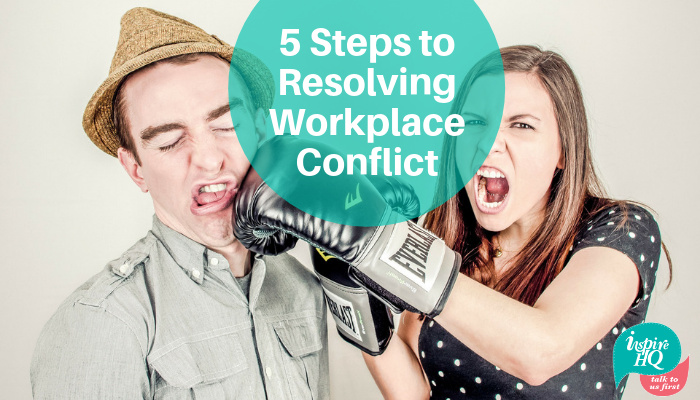You arrive at work and you know something is off. There is tension in the air. Whether this is a new issue or been growing over time, you know you need to address it. As a HR professional, resolving conflict is part of our remit and a skill we use regularly. But as a leader or business owner, you may be at a loss as to where to start.
I recently listed to a highly information and practical podcast by Cy Wakeman, New York Times bestselling author, which mirrored my experiences and thoughts on dealing with conflict, and put them into a straightforward model.
Cy talks about the most common approaches to managing conflict, which I see all too often:
- Ignore it: you are adults, you’ll either lose interest or work it out for yourselves.
- I’m the boss: I’ll be the judge about what is going on and how you’ll work together, I’ll work it out for you.
- The compromise: I can’t decide who is right or wrong, so I’ll ask you both to adapt, ie you’ll be less direct and you’ll be more understanding of their approach when under pressure. Again, I’ll work it out for you.
In all of the above situations, no-one comes out feeling like a winner. So how do we get to a win/win solution? Cy says our role as leaders is to ‘change mindsets, not circumstances’. To achieve this we need to:
- help them to understand their roles,
- help them see their situation differently,
- call them up to greatness, and
- hold them accountable to what they commit too.
Cy’s approach is not dissimilar to my own. By treating them as adults and professionals, capable of working together to find their own resolution, they are more likely to own the outcome and see it as a win/win. Let’s work through Cy’s approach with a real example:
Mary and Joe work in an accounting firm. Their roles mean they need to work together to be able to service the customer. Mary says Joe is lazy, spends too much time socialising and doesn’t provide her with the help she needs. Joe says Mary is too pedantic, takes too long to get her work done and it’s her own fault she gets behind.
- What’s the reality? (non-negotiable)
In clear and succinct terms, state the reality of the situation. Without revisiting the past or making it personal, paint them a picture of how you currently see the situation. Then help them see what strengths and/or values each bring to the business/team. The purpose of this statement is to put them on equal footing.
‘The two of you who have lost trust and respect for each other, and are unable to work as a team. Mary your work is to a very high standard and you are always focussed on delivering the best result for our customer. Joe you have a great rapport with the customers and bring a real energy to the team’.
- What’s the goal? (non-negotiable)
Tell them what outcome you want to see, what is the goal of this resolution process. I find it really useful to have this as a visual reference that they can see throughout the conversation.
‘Goal: We need to work as a team to provide the best results AND friendly service our customers’.
- What are you going to do? (negotiable)
This is where you role goes from leader to facilitator and you guide the conversation by continually asking question, but offer no solutions.
‘What’s your solution to this situation?’
As the leader you may need to veto some ideas that aren’t viable, eg ‘we’ll be separated into different teams’. Continue to ask ‘what other ideas do you have?’
If they veer off track into personal attacks or past hurts, help them reframe their conversation from the personal ‘what is wrong with the other person’, into the professional ‘what are we trying to achieve’. Ask ‘is this discussion going to help us achieve our goal?’
Cy’s top techniques for calling out resistant behaviour:
- For those focussed on blame, remind them that this process isn’t about right or wrong, ask ‘do you want to be right or be happy?’
- To stop judgement and assumptions, ask ‘what do we know for sure?’
- If they can’t let go of the past, ask ‘is there any way you can put that aside so we can focus on how to make this situation better?’
- Get them to commit? (non-negotiable)
Whenever the conversation reaches a point where a resolution is agreed to (and there may be more than one), note it down. At the end of the conversation, read back all the resolutions and seek their commitment. Then provide it to them in writing.
- Hold them accountable (non-negotiable)
This part is fairly self-explanatory, but I’m amazed at how often the resolution process ends at the agreement stage. As leaders we need to check in with the staff, both individually and together, on how they are tracking against the agreed actions. Provide feedback, both positive and constructive, to keep them on track.
Preventing conflict
Lastly I want to talk about what we can do as leaders to prevent conflict. So often when I work back through the issues that have led to the conflict, one of the root causes is a lack of clarity in what are the goals and what is their role. If we don’t remove the ambiguity and make this clear, their individual assumptions don’t align and this often leads to conflict.
If Mary and Joe had clarity on what is the definition of good customer service, how do we provide it and what is their role in delivering it, we might have avoided the conflict. I can’t emphasise enough the value in leaders regularly spending time clarifying goals, roles and processes. Removing the ambiguity, also removes the opportunity for misunderstanding and help builds alignment to common goals.
Resolving conflict takes time, courage and patience. But if you can take on the role of facilitator, rather than fixer, you will upskill your staff and will deliver a sustainable resolution, and a more positive culture.
Claire Huntington has over 15 years’ experience in senior and executive level human resource management and strategic leadership positions. Claire learnt HR under the wings of great mentors and through trial and error. She has a very practical hands-on approach to HR and management, and isn’t afraid to look outside the box. Claire is also mum to three primary-school aged firecrackers and is an avid photographer in her spare time.
Disclaimer: The material contained in this publication is of a general nature only. It is not, nor is intended to be, legal advice. If you wish to act based on the content of this publication, we recommend that you seek professional advice.

